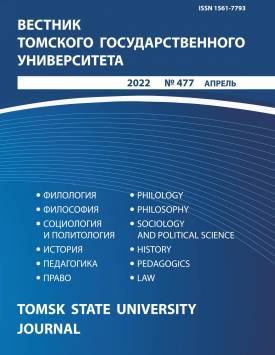Motivation for the participation of Soviet youth in Komsomol construction projects during the Khrushchev Thaw (on the example of the Krasnoyarsk Hydroelectric Power Station)
In this article, the authors analyze the Soviet youth's motivation to participate in Komsomol construction projects in the 1960s on the example of the construction of the Krasnoyarsk Hydroelectric Power Station. The aim of the article was to identify groups of motivational attitudes of the Soviet youth during the Khrushchev Thaw, which encouraged young people to leave their homes and go to the sparsely populated areas of the country for Komsomol construction sites. Primary data were collected using the method of in-depth semi-structured interviews. The study involved 17 respondents - builders and pioneer builders of the Krasnoyarsk Hydroelectric Power Station and the city of Divnogorsk, who arrived for construction between 1956 and 1972. In addition, a significant part of working with data was the qualitative analysis of the media on the example of the texts of the printed edition - the Soviet newspaper Pravda. The sample of materials included articles printed at the first stages of the construction of the Krasnoyarsk Hydroelectric Power Station and containing information about the construction itself. Their analysis revealed the specifics of the context of construction in Krasnoyarsk and its features that contributed to its popularity among young people and effectiveness in terms of youth policy. As a result of qualitative processing of interview scripts with the participants in the construction of the Krasnoyarsk Hydroelectric Power Station by coding, two main groups of motivating factors were identified: material and non-material; the latter, in turn, were divided into personal, that is, significant directly for the respondent themselves, and ideological, significant for society. With a pronounced ideological background of the events that took place and, as a result, clearly identified and significant ideological incentives, the group of material factors also influenced the decision-making process to join the construction of the Krasnoyarsk Hydroelectric Power Station. Consequently, we can see the balance of economic and ideological aspects in stimulating the Soviet youth to participate in the construction of the Krasnoyarsk Hydroelectric Power Station, as well as a significant impact of the media on the formation and actualization of motivational attitudes. However, the qualitative methodology chosen by the authors for the study does not allow to give answers to several questions about the ratio of groups of motivational attitudes, as well as to conclude that the importance of certain groups of attitudes is paramount. At the same time, the grounded theory that the research has been based on allows the authors to continue working in the field to correct the model, saturating it with new empirical material.
Keywords
motivation, youth policy, Krasnoyarsk Hydroelectric Power Station, young people, motivational attitudes, Komsomol constructionAuthors
| Name | Organization | |
| Kasamara Valeria A. | National Research University Higher School of Economics | vkasamara@hse.ru |
| Chebanova Daria S. | National Research University Higher School of Economics | dschebanova@edu.hse.ru |
References

Motivation for the participation of Soviet youth in Komsomol construction projects during the Khrushchev Thaw (on the example of the Krasnoyarsk Hydroelectric Power Station) | Vestnik Tomskogo gosudarstvennogo universiteta – Tomsk State University Journal. 2022. № 477. DOI: 10.17223/15617793/477/9
